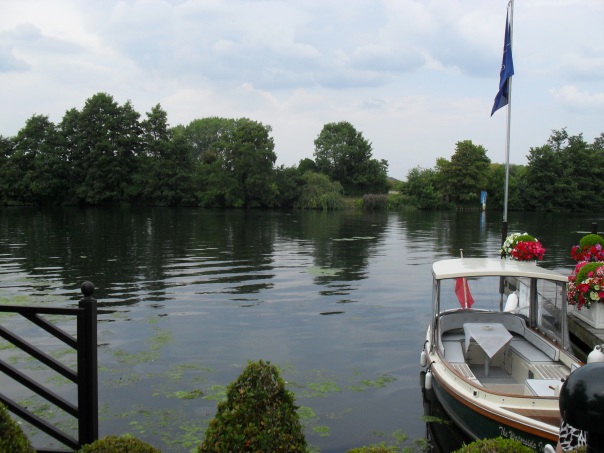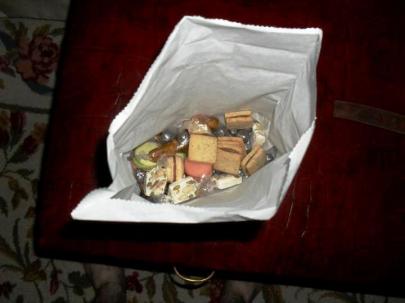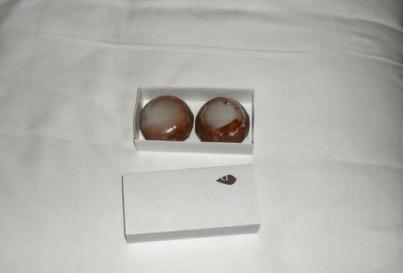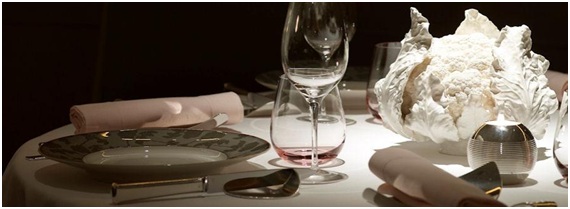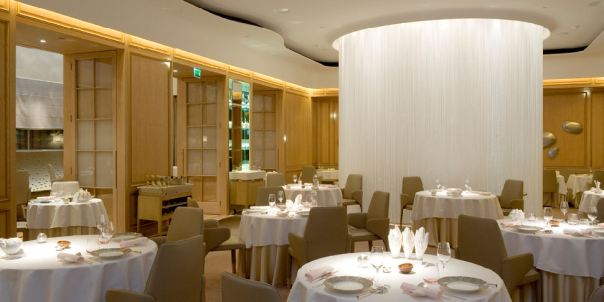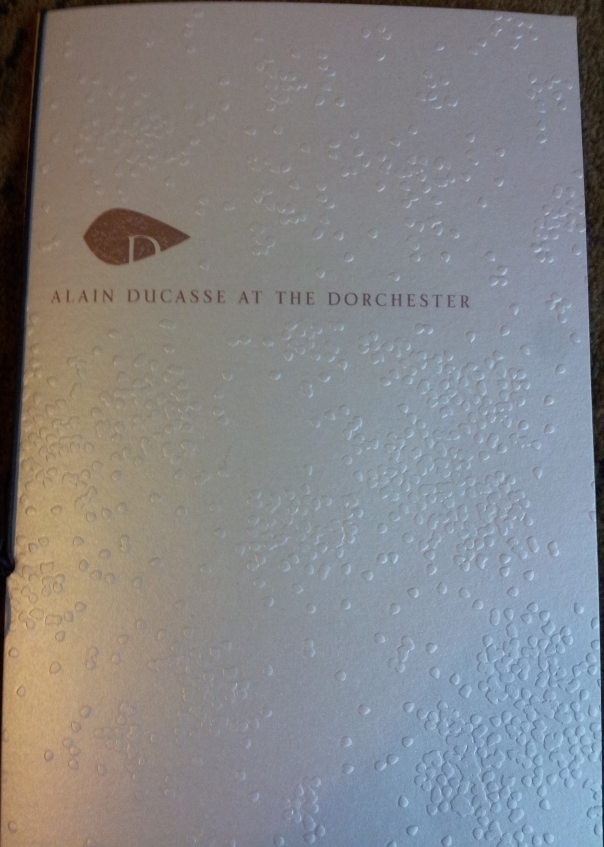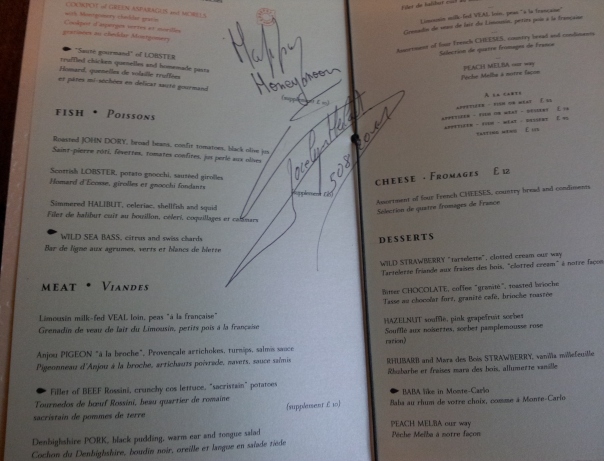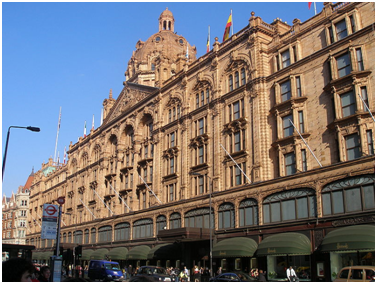Blog Archives
Best of 2011: Restaurant Dish of the Year
As you’d expect given the incredible foodie year I’ve had, I’ve eaten some truly sublime things in 2011. Here I run down the best dishes I’ve eaten overall, and the best dishes I’ve eaten in my home city of Manchester, during the last 12 months.
TOP 10 RESTAURANT DISHES OF THE YEAR (OVERALL)
- Warm Raspberry Soufflé [The Waterside Inn, Bray – August]
Out of everything I’ve eaten this year, this is the one I find myself day-dreaming about the most. My mouth moistens, my memory goes back to a perfect summer’s evening and I want more than anything to be sat in the dining room of The Waterside Inn, gazing out over a moonlit river and eating this faultless raspberry soufflé.
I’ve had many more profound eating experiences during 2011; revelations that changed my whole outlook on food. But this relatively simple dessert handily beat each of them in the most important category of all – taste.
I had often wondered what the fuss is with soufflés; this featherlight version, with the texture of a celestial cloud and the intense flavour of fresh English raspberries (aided by a tart raspberry coulis), explained it better than words ever could. A symphony of pleasures from the moment it arrived on the table to the last spoonful, no dish has ever given me greater joy – and I think it might be a long time before another gives as much again.
2. Roast Foie Gras, Isle of Skye Sorrel, Gooseberry & Cardamom [Hibiscus, London – July]
3. Fillet of Beef Rossini, Crunchy Cos Lettuce, “Sacristain” Potatoes [Alain Ducasse at The Dorchester, London – August]
4. Seared Scallop, Pea Purée, Toasted Coconut and Morteau Sausage Emulsion [Hibiscus, London – July]
Done correctly, scallops can be remarkable little morsels – jewels of the sea – but I had no idea how good they could be until I had this dish, with a big, fat, hand-dived specimen at its centre. The accompaniments were impressively made and the whole dish was beautifully presented and cooked, but it was Mother Nature who made it sing through the creation of this exquisite central ingredient. So fresh and so sweet, it almost makes me scared to order scallops again in case they’re just not this good.
(You can see a picture of the dish, as well as a picture of the number ten on this list, here, via Nordic Nibbler. I think I might’ve actually been there on the same night as him as I had the first four dishes he had, as well as the same amuse bouche, pre-dessert and first dessert course.)
5. Roasted Challandais Duck with a Lemon and Thyme Jus, Potato and Garlic Mousseline [The Waterside Inn, Bray – August]
The Waterside Inn is all about the duck. They float down the Thames as you sit out on the terrace, pictures of them adorn the walls and menus, and the smell of them roasting permeates every inch of the restaurant (delightful when you’re waiting for your food, not so delightful when you wake up hungover in the morning).
I believe it hasn’t been off the menu since it opened well over three decades ago and I found out just why when I had the chance to try it: it’s a total classic. I loved the theatre of the whole duck being presented at the table then carved in front of us. I also loved the little puff pastry duck served alongside it. But, as you’d expect, the dish was really all about the duck itself, which was stunning.
It was supremely old-fashioned, and it looked it, but this is my sort of food. If I ate at The Waterside Inn ten more times, I don’t think there’d be a single occasion where I wouldn’t order the duck.
(You can see a picture of the dish, as well as a picture of the number nine on this list, here, via Food-E-Matters.)
6. Porterhouse & Bone In Rib-Eye Steaks (150-day Corn Fed USDA Angus Beef), Hand Cut Chips [Goodman Mayfair, London – August]
7. Baba like in Monte-Carlo [Alain Ducasse at The Dorchester, London – August]
8. Macerated English Raspberries, Fine Puff Pastry Layers, Lime and Yoghurt Custard, White Chocolate Shards [Northcote Manor, Langho – August]
9. Terrine of Foie Gras with Lightly Peppered Rabbit Fillets and Glazed with a Sauternes Wine Jelly, Salad of Chinese Cabbage Leaves and a Violet Mustard-Flavoured Brioche Toast [The Waterside Inn, Bray – August]
10. Tartare of King Crab, Sweetcorn, Meadow Sweet & Smoke Kipper Consommé, Sea Herbs [Hibiscus, London – July]
This dish was my intro to two-star Michelin cooking and I could immediately see the difference between it and everything I’d had before at one-star level. “The Red Guide inspectors aren’t completely clueless,” I thought. It was an unusual dish, absolutely nothing like anything I’ve ever had before or since, but it was such an awesome way to start a meal. A fascinating exploration of different tastes and textures, it was a real treat for the senses, and one I don’t think I’ll ever forget.
TOP 5 RESTAURANT DISHES OF THE YEAR (MANCHESTER)
1. Bone In Sirloin (Belted Galloway), Bone Marrow, Mushroom, Chips [Smoak, City Centre – October]
2. Rib-Eye Steak, Chips, Humitas, Baby Gem salad, Tender Stem Broccoli and Peppercorn Sauce [Gaucho, City Centre – July]
Gaucho might not do the best steak in town anymore, but I’ll be damned if it doesn’t still do a bloody good job. Had an excellent meal there on my stag do, the highlight of which was a main course featuring humitas (a paste of sweetcorn, onions and goat’s cheese, boiled in a corn husk). I’ve never been a big fan of sweetcorn, but these were a revelation – a wonderful sweet accompaniment to the perfectly-cooked beef.
3. Eccles Cakes with Double Cream [The Mark Addy, Salford – November]
When I got married earlier in the year, I had an Eccles cake mountain instead of a traditional wedding cake (below). It looked good, it tasted good; the guys from Slattery’s in Whitefield did a great job. But when I tasted the Eccles cakes at The Mark Addy a few months later, my first thought was: “Why the hell didn’t we get these guys to do our Eccles cakes instead?” Absolutely gorgeous and, as I said in the comments here, the best I’ve ever had.
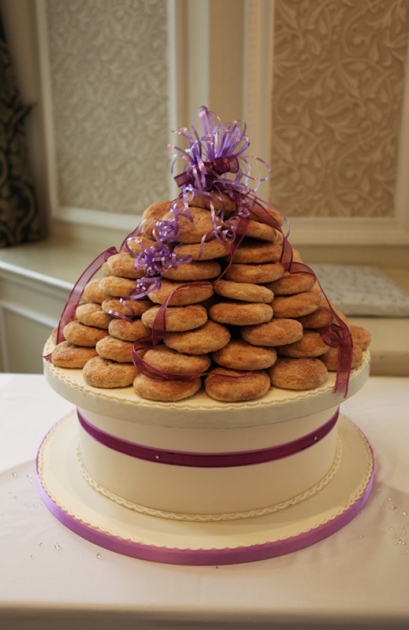
My Eccles cake wedding cake, or as Michelin-starred chef Alexis Gauthier described it: "Brilliant croque en bouche a l'Anglaise."
4. Pigeon, Bury Black Pudding, Belly Pork, Apple [The Lime Tree, West Didsbury – November]
5. Chicken with Garlic [Kyotoya, Withington – November]
Best of 2011: Restaurant Meal of the Year
2011 has been a pretty amazing year for me in terms of food. Over the next few weeks, I’ll be recapping the very best (and worst) of it, starting with Restaurant Meal of the Year.
I’ve experienced five of the six best meals of my life during the last 12 months. In an incredible four-week period following my late-July wedding, I had fabulous dinners at Hibiscus (2 Michelin stars), Goodman Mayfair, The Waterside Inn (3 Michelin stars) and Northcote Manor (1 Michelin star).
However, one meal from the same period stood out above all the rest to be the best of the year, and indeed, the best I’ve ever had. That was the meal at 3-Michelin-starred Alain Ducasse at The Dorchester.
I’ve spoken at some length about my beef Rossini main course and rum baba dessert, but I haven’t gone into much detail about the rest of my dinner, which was brilliant from start to finish. Seared foie gras was served in the most perfect duck blood sauce; sumptuously rich and smooth as velvet. A stunning piece of sea bass had its own wondrous adornment; a delicate citrus sauce which balanced like Nadia Comăneci in 1976.
Each of the extras gave me so much pleasure: the charming little cheese puffs that began the evening; the immaculate broccoli purée that followed. I’d struggle to fault the bread selection – every piece lovely in texture and full of flavour. Ducasse supposedly refuses to serve his bread warm as he doesn’t want his diners to fill up on it and spoil the rest of their meal, so I was surprised and delighted to find these specimens still hot from the oven. Strikingly good butter from Neal’s Yard and an interesting cream cheese provided fitting accompaniments.
But the best of the nibbles were saved until last. Flawless macaroons and chocolates were merely preamble to the treasure trove of treats that awaited on the bonbon trolley. Marshmellows, nougats, caramels, pastries, cakes – it was a feast fit for a fat kid with the most discerning of tastes.
I was too full at this stage so I got my waiter to fill a bag for me. I was able to gorge on it for the next three days and still had plenty left to give to friends.
Away from the food, things were just as special. The waiters gave a masterclass in service, effortlessly juggling attentiveness, efficiency and professionalism with enthusiasm, friendliness and charm. Along with the marvel that is the Alain Ducasse dining room – far prettier than it looks in pictures – and the palatial luxury of The Dorchester itself, the staff provided the backdrop and ambience to an evening I’ll never, ever forget.
Below is everything I ate in full. Regrettably, aside from Alain Ducasse’s signature champagne, I cannot remember what we drank with the meal, other than it being quite outstanding; equal to the food and setting in both quality and price.
Even more regrettable is the fact that I’m not able to add these orange cakes on at the end. They were presented to us as a gift as we left the restaurant and the following day my wife scoffed both in secret, not allowing me a single crumb.
If that’s not grounds enough for divorce, I don’t know what is!
======
A LA CARTE
Amuse Bouche 1
Gruyère Gougéres, Paprika Gougéres
*
Les Pains
Sourdough, Black Olive Bread, Fougasse with Bacon
*
Amuse Bouche 2
Royale of Broccoli with Crispy Vegetables
*
1st Course
Foie Gras de Canard Poelé, Cerises, Amandes Fraiches
Seared Duck Foie Gras, Cherries, Green Almonds
*
2nd Course
Bar de Ligne aux Agrumes, Verts et Blancs de Blette
Wild Sea Bass, Citrus and Swiss Chards
*
3rd Course
Tournedos de Boeuf Rossini, Beau Quartier de Romaine, Sacristain de Pommes de Terre
Fillet of Beef Rossini, Crunchy Cos Lettuce, “Sacristain” Potatoes
*
Pre-Dessert
Macaroons, Chocolates
*
4th Course
Baba au Rhum de Votre Choix, comme a Monte-Carlo
Baba like in Monte-Carlo
*
Mignardises & Gourmandises
The Bonbon Trolley
======
Not by any stretch worth the same number of words, but perhaps worth a bit of a laugh, is my Worst Restaurant Meal of the Year – a truly traumatic experience.
I’ve always had a bit of a problem with Café Rouge after an awful meal at one of its branches in 2005, but nothing could’ve prepared me for the bile served at my work’s Christmas Party. Food is always pretty terrible at Christmas dos, and indeed it’s part of the fun, but this was a serious ordeal; one that conjured up images of Vietnam War movies and Colonel Kurtz whispering “the horror, the horror”.
Unless you were there and had the parsnip and chestnut soup, roast turkey, and Christmas pudding, you’ll never be able to understand just what I and others had to go through that night. But I hope my descriptions of what I imagine made up each dish will at least give some insight into the tragedy that befell my senses and digestive system on that cold December evening.
======
CHRISTMAS PARTY MENU
Soup de Panais
Diarrhoea of Polly Filler-Fed Dog, Essence of Chip Shop Curry, Tree Bark
*
Dinde Rôtie
Reconstituted Turkey and Woodchip, Mould of Soup de Panais, Memory of School Dinner Sprouts, Assortment of Miniature Rubber Dildos, Raw and Nuked
*
Pudding de Noël
Dried Guinness Poo, Cat Vomit
======
Food #7: Alain Ducasse Rum Baba
At the very top of my restaurant wishlist, standing head and shoulders above all the other three-star Michelin places in the world, is Le Louis XV at the Hotel de Paris in Monte Carlo.
With its iconic Monaco setting, palatial dining room and a menu that promises to deliver all I’ve ever dreamed of, the ode to opulence that is Alain Ducasse’s flagship seems to offer everything I want from a fine dining experience.
As you’d expect from a restaurant so revered, a number of its dishes have become very famous. The one that springs to mind quicker than almost any other is Ducasse’s signature rum baba, which has been so venerated over the years it has become the standard by which all other babas are judged. No mean feat, considering it’s such a classic dish.
My chances of getting to Le Louis XV and tasting the food there any time soon are somewhere between sod and bugger all, but thankfully there are a couple of options for people like me who want to get a little slice of the great restaurant in the UK. Alain Ducasse at The Dorchester and its ‘Baba like in Monte Carlo’ is, unsurprisingly, chief among them.*
Ducasse’s debut London restaurant received a real beating from critics when it opened in 2007 and its reputation has yet to fully recover. Its three-star rating is the butt of many a joke about the UK Michelin guide and its absence from this weekend’s Sunday Times Food List, featuring the 100 ‘best’ restaurants in the UK, was glaring.
But more recent critiques from people I trust indicated that Alain Ducasse had gotten over its rocky beginnings and started producing very accomplished food,** with its desserts in particular drawing a lot of praise.
Two separate reviews saying that its rum baba was every bit as good as the one it was recreating from Le Louis XV were all I needed to hear to decide I wanted to visit. This was an item off my Foods To Try Before You Die list I was really going to go out of my way to eat.
Ducasse’s baba au rhum is a dish of real showmanship. A beautiful silver*** tripod with a domed lid was placed before me by one waiter, who allowed me to stare at it with lustful anticipation for a few seconds before sliding back the lid to reveal the treasure inside. A silver bowl, shined to mirror-brightness, held snug a perfect sponge; an exquisitely moist yeast cake, split down the centre in a slightly yonic manner to show the contrast between the golden sheen of its exterior and the fluffy white of its innards.
I was given a few more seconds to take in stage one of the spectacle before stage two began – a sommelier arrived with a tray carrying six different bottles of premium rum. Each was presented to me and described, and I was asked to decide which I wanted. I know this dessert wasn’t free, and in fact it was costing me about £20, but dear god did this bit make me feel like I was being treated by a very generous host. It was a dazzling bit of theatre.
I selected one that had honey notes and watched as it was poured liberally over the sponge, which imbibed half and bathed in the rest. The adorning of the baba was completed by another waiter, who with a pair of spoons expertly widened the split down the middle of the cake and heaped a couple of large dollops of vanilla cream on top.****
“Enjoy,” is what I think I heard the captain say as the three waiters moved away from the table. I was in a sort of deep trance by this stage, so I’m not entirely sure. Sat in front of me was arguably one of the world’s great desserts; razzmatazz had set the stage, and all that remained was for me to do my bit and eat the bloody thing.*****
No pressure then. I was almost nervous!
When you think about rum baba, it’s not that exciting. Sponge, cream, rum – that’s it. On paper a trifle is more exhilarating. But Alain Ducasse has helped to lift this very simple-sounding dish to oxygen-depriving culinary heights.
The sweet, light as a feather cake – which somehow managed to be soft and delicate, heavy and rich all at the same time – was a wonder on its own. Soaked in luxury rum and flawlessly complemented by the vanilla cream, it reached celestial levels. Each spoonful was indulgence in its purest, most wicked form; it was the ultimate comfort food.
The intoxicating aroma was every bit as important as the taste. I imagine the bowl had a lot to do with it, but it was like everything in the atmosphere around me and the food had been infected by the dish, making me feel I was eating in some sort of hedonistic, rum-fuelled dream. Food sweats added to the fever experience – admittedly not in a good way – and I began to feel a little drunk.
At one stage I worried I might not be able to finish. After three courses and the week of fine dining that was my honeymoon, it was probably a little bit much, but I persevered and got it down me. When you’re eating a dessert of the very highest standard, you can’t let a little thing like an engorged stomach stand in your way.
I went into this dish with monumental expectations and it met every single one. The food couldn’t be faulted, but it was the presentation that cemented the legend.
Is Alain Ducasse’s rum baba one of the world’s great puddings? You bet your arse it is.
Verdict: Highest possible recommendation
NEXT UP: Potted shrimp
——————————
*The other one is Gauthier Soho, which offers a dessert titled ‘Louis XV’, a version of the legendary chocolate croustillant that’s always on the menu at the Hotel de Paris and will always be on my list of Foods To Try Before You Die. The original has been called the best dessert in the world and chef Alexis Gauthier is fully qualified to deliver a masterful take on it, given that he probably made it thousands of times while working pastry for Ducasse in Monaco. I’m very keen to visit.
**I can confirm that this is true and we had an amazing dinner at Alain Ducasse. I’d say only the desserts were three-star worthy, but the rest of our meal was capably at two-star level. I loved the dining room, the service was sublime and as an overall experience, I think it offers one of the best in the UK. The key is to go in with an open mind and forget about the price.
***It’s gold at Le Louis XV. Apparently The Dorchester isn’t posh enough to have all the trappings of Monte Carlo…
****There’s a good gynaecology joke in this somewhere, but like a clitoris I can’t seem to find it.
*****If you want to see what it looked like, check out this pic from The Boy Who Ate The World.
Food #6: Beef Rossini
Every so often you come across a recipe which instantly makes you think to yourself: “How the hell have I never heard of this before? How is it that this food is yet to pass my lips? Where is the big pile of broken glass I can crawl over – fly unzipped – to get it?”
Beef Rossini (aka Tournedos Rossini), invented by king of chefs and chef of kings Auguste Escoffier* in tribute to the famous composer, conjured up all these feelings and more when I first read about it towards the end of last year and immediately went on my list of Foods To Try Before You Die. How could it not when the basic recipe consists of pan-fried fillet steak, a slice of whole foie gras, a crouton, black truffle and a Madeira demi-glace sauce?
Have we all stopped slobbering yet? Good. Then let’s carry on…
I’ve harped on before about how much I love beef, but what I haven’t touched on is how scared I am of ordering it in restaurants these days – or at least how scared I am of ordering it in restaurants that don’t specialise in dead cow. I’m genuinely frightened of it being a disappointment. Beef is my favourite food in the whole wide world and if anything short of stunning arrives on my plate, I’m going to wish that I ordered something else instead.
So it says a lot about how appealing beef Rossini is that I ordered it without hesitation when presented with it on a menu at Alain Ducasse at The Dorchester this summer.**
The version they serve at Alain Ducasse is slightly different from what I’ve described above. Instead of a crouton, there was a thick piece of toast. The truffles and Madeira demi-glace were combined in a Périgueux sauce. Crunchy cos lettuce drizzled with vinaigrette, which you’d imagine was just a side, was a fundamental part of the dish.
And it was all so perfect; I couldn’t imagine it being done any other way. The beef and the foie gras and the truffle sauce just belonged together, offering an exquisite marriage of richness and corruption that you only tend to find among Premier League football club owners.
The toast soaked up all the flavours beautifully and added some extra texture to the plate. The freshness and acidity of the dressed lettuce cut through the richness like a guillotine in 1793; its vibrant green helping my eyes to survive the onslaught of brown.
Combined, it tasted like the greatest burger you could possibly imagine. It was absolutely brilliant.
(You can see a picture of it on the Food Snob Blog here.)
The kitchen obviously deserves a lot of credit for cooking it all so precisely, and the amendments to the traditional dish (lettuce, toast) were masterful. The delightful sacristain potatoes that accompanied – peppery, spiral crisps that take a staggering amount of work to produce – iced the proverbial cake with further texture and flavours.
But the real kudos should be reserved for the inventor of beef Rossini – whoever that may be. My overriding feeling, as I pushed knife and fork into the centre of the plate*** and waited for one of the excellent waiting staff to take it away, was that I’d just eaten one of the world’s great dishes. A recipe conceived by a genius – one that if you stay faithful to it, will deliver time and time again.
I’ve had much better beef than the fillet steak I had here. I’ve had better foie gras too. In fact, I had superior versions of both ingredients mere days before my trip to Alain Ducasse. But I’ve yet to have a whole dish involving either beef or foie gras that was anywhere near as good as this beef Rossini.
To be honest, I might not have eaten anything as good in my whole life.
Verdict: Highest possible recommendation
NEXT UP: Rum Baba [at any Alain Ducasse restaurant]
——————————
*This seems to be the most common belief anyway. I’ve seen it said that Escoffier’s roi de cuisiniers et cuisinier des rois forebear Antoine Carême actually came up with it – either way, beef Rossini is a dish with serious pedigree.
**I was also thinking that if I can’t trust a three-star Michelin restaurant to get beef right, I might as well just give up eating the stuff altogether.
***I loved the plate, by the way. It looked very plain, but there was a really subtle, almost imperceptible, decline towards the centre, which pooled the sauce and saved me having to chase it around the plate with the other ingredients. Just one of those little details that makes you realise the amount of thought and effort a restaurant like this puts in to trying to give you a perfect dining experience.
How to choose a three-star Michelin restaurant in Paris
In the next 15 years, I might only get one shot at a ‘meal of a lifetime’. In 2012, I’m going to Paris, and that’s probably going to be it. Money’s one reason, the prospect of kids another. I have to be realistic and concede that there isn’t going to be too much fine dining going on in my immediate future.
Basically, I need to make my one shot count.*
Three-Michelin-starred restaurants in the UK aren’t all they’re cracked up to be. There are four and only Heston Blumenthal’s The Fat Duck is considered truly three-star worthy. Not even that is thought to be a match for the very best restaurants abroad.
I’m not saying you won’t have a great meal at any of the top British places. Indeed, I had fabulous experiences at Alain Ducasse at The Dorchester and The Waterside Inn, both of which I visited recently. But if you’re after culinary perfection and want to see what it tastes like at the absolute pinnacle of world gastronomy, you’ll have to travel to a foreign country to find a restaurant that fits the bill.
Luckily for me, Paris seems to have quite a few.
There are currently ten restaurants in Paris with three Michelin stars.** I can only afford to go to one, but the choice is too rich and the stakes are too high to just pick it off the cuff. I need to make sure I go to the RIGHTone. A place that not only offers the food dreams are made of, but can offer it with exceptional service to an ignorant Englishman and his dairy intolerant wife, neither of whom can speak a word of French.
So I’ve done exactly what I have to do when faced with any tough decision: I’ve made a spreadsheet in Excel, invented a tremendously geeky 100-point scoring system, and done some research.
Here’s the result – my 8-step guide for choosing a three-star Michelin restaurant in Paris:
======
Step #1: Food

Whole Grilled Sea Bass with Sweet Spices at the three-Michelin-starred Restaurant Guy Savoy in Paris
The first thing to look at, naturally, is the quality of the food. These places don’t send free samples of their dishes 400 miles overseas, unfortunately, so what you’re after is reviews of each restaurant that are trustworthy, comparable and that allow you to score them out of 10.
Andy Hayler and his essential 3 Star Restaurant Guide website, which features reviews of every three-star Michelin restaurant in the world, is a great place to start. His opinion is one that I rely upon and he’s scored all the three-stars out of 10 for you already, so it doesn’t take much work.
Food is obviously one of the most important factors, so it needs a suitably hefty weighting within a 100-point system. I multiplied Mr Hayler’s marks by three, to give a score out of 30.
Step #2: Menu

The front of the menu at three-Michelin-starred Le Pre Catalan in Paris, along with the first page of starters. Note the scary prices.
The second thing to do is track down menus for each of the restaurants and rate them based on how exciting they look. This is much more time-consuming and a bit of a pain, but it’s essential if you don’t fancy going in somewhere blind.
A few of the restaurants only have menus available on their websites in French, so it can take a bit of effort to find out what is what. Some of the others don’t have menus available at all, so you’ll need to fish around on review sites (thanks again Mr Hayler) to get a vague idea of the sort of food they offer.
The menu’s not as a important as the quality of the food, but it is more important than some of the steps coming up, so I’d suggest giving these marks out of 20.
Step #3: Dining room
After that, look up pictures of the restaurants’ dining rooms. A combination of Google Images and official websites should see you right, but again Mr Hayler has the odd snap and the Food Snob blog can be good.
This might not be as important to some as it is to me, but my thinking is: “Can a meal truly feel special if you’re sat somewhere rather ordinary? Not if you’re paying these kinds of prices, it can’t. I want to eat in a place that looks and feels amazing.”
Score this out of 10.
Step #4: Star quality

The iconic and revolutionary three-star Michelin chef Pierre Gagnaire, whose eponymous flagship restaurant is based in Paris
It’s great being taken by surprise and wowed by somewhere you’ve never heard of before, but there’s something extra exciting about being cooked for in a prestigious restaurant by a superstar chef.
Think about the reputation of the place and the foodie bragging rights you can attain by going there, and add another mark out of 10.
Step #5: Websites
This is hugely superficial and I might be way off track, but my fear of eating in a restaurant where I don’t speak the language and having to explain an allergy are forcing me to put a lot of stock in website quality. I want it in English, I want the menu to be in English and I want to be able to book online. To me, these things say: “We welcome English custom and will accommodate English people as best we can.”
The ones which are completely in French or simply consist of a blank page and a phone number (I’m looking at you, Ledoyen), do not.
Mark this out of 30.
Step #6: Price

The price of the 2011 autumn tasting menu at Le Meurice. It’s not the cheapest in Paris, but by no means is it the most expensive.
If you don’t have a limitless budget, you should probably be hunting around for the best value. Look at the cost of the tasting menu and note this down. If you can’t find the cost of the tasting menu, or the restaurant doesn’t offer a tasting menu, just make it up. You can generally get the jist with a bit of Googling.
Don’t give the price a mark, leave the number exactly as it is.
Step #7: Maths time

My Excel calculations. My wife called me a geek when she saw this, but she had no idea I was secretly kicking myself for not adding the code to round the totals up and down automatically. I’m sure that would’ve changed her mind.
Take your score out of 100 (steps 1-6 added together) and divide it by the price. Multiply by 100 and round up or down to get a whole number. Whichever ends up with the highest overall rating is the three-star restaurant you should visit.
Example based on average scores: (27 + 12 + 8 + 6 + 14) / 280 x 100 = 24
Step #8: Cheat
If the restaurant with the highest score doesn’t look like the one for you, then change the mark weightings until you get the one you want.
Let’s just say the website score didn’t become out of 30 until I needed it to…
======
And there you have it. A completely foolproof (aka not at all foolproof) way to choose a three-star Michelin restaurant abroad.
In my next post I’ll reveal what happened when I fed some numbers into my system and which of the ten restaurants came out on top.
Anybody care to take a guess where I’m going?
—————————
*I started writing this post days ago and I’ve still not been able to get Lose Yourself by Eminem out of my head. I suppose that’s what you get when you talk in clichés.
**The ten, as of October 1st 2011:
L’Ambroisie
L’Arpège
L’Astrance
Le Bristol
Guy Savoy
Ledoyen
Le Meurice
Pierre Gagnaire
Plaza Athénée
Le Pre Catelan
You can read the follow up post to this one here: How to choose a three-star Michelin restaurant in Paris: The result
A chocolate adventure
I’ve never really liked chocolate. Crisps have always been my unhealthy snack of choice if I’m feeling peckish. Sweets are what I go for if I want something, well, sweet. Even with biscuits, I’ll choose plain Hobnobs and Digestives over their chocolate-covered counterparts.
In restaurants I avoid chocolate-heavy desserts like the plague. When people bake cakes for charity at work, I tend not to buy one if there’s chocolate in it. In fact, it’s incredibly rare I buy chocolate at all.
Occasionally I’ll get a Kit-Kat Chunky or a Twix to fill a hole while I’m waiting for my train to arrive at the station, but I don’t particularly enjoy them. I buy simply because chocolate is an acceptable food to eat while you’re hungry, and people give me funny looks when I eat slices of Warburtons Toastie straight from the packet.
I feel no different about chocolates. Sure, I eat them when offered or when my allergic wife gets given a box or two at work, but they never register higher than a ‘meh’ on the pleasure meter. I sometimes wonder why I bother eating them at all.
‘Good’ chocolate hasn’t done much for me either, although admittedly I’ve not had much of it. I tried a few of William Harcourt-Cooze’s bars, which were nice but forgettable. My parents brought me back a fantastic little box of chocolates from Belgium a few years back, but it didn’t exactly have me rushing out for more.
Even this fabulous pudding at Northcote Manor two years ago left me wishing I’d had something else instead:
======
“Tiny Chocolate Desserts” Liquid Chocolate, Chocolate Brúlee, Jelly, Sorbet, Malt and Smoke
Bouteille Call, Bonny Doom, Santa Cruz, California
======
My list of Foods to Try Before I Die tells the story as good as any. There are just two chocolate-based items on there: Valrhona chocolate, supposedly the best chocolate in the world, and Le Louis XV’s famous chocolate croustillant, supposedly the best dessert in the world. The word ‘best’ is the only reason they’re included – the thought of eating them doesn’t exactly fill me with excitement.*
Chocolate has always been, quite simply, not for me and it was never going to be for me. At least until one day when, out of nowhere and almost by accident, a man named William Curley entered my life.
I think he might’ve begun to change my mind.
Harrods Food Hall – or rather, series of halls – is one of the best places to visit in London. Each room is beautiful in its own right, but packed to the gills with the very finest ingredients, carefully displayed, they become a sort of culinary cathedral; a place where foodies go to worship.
I defy even the most indifferent of eaters not to be amazed by some of the produce on show. At the very least, some of the prices should make you go weak at the knees. From the hampers and the fish hall to the patisseries and the bread, it’s an Aladdin’s Cave of gastronomic delights.
Had I purchased everything I desired as I walked through the rooms, I think I would’ve gone bankrupt within five minutes. Instead, in what I consider quite a remarkable feat of restraint, I managed to restrict myself to just two things: a sandwich** and a box of chocolates.
Perhaps chief among the wonders of Harrods Food Hall is the chocolate room. Even I, utterly apathetic about the brown sugary stuff, had to marvel at it. Artisan chocolates are everywhere you look, with stand after stand featuring shelf after shelf of world class confectionary. The stalls are grouped by country, so you get to tour the globe as you do your circuit. The Italians are there, the Swiss, the Belgians, the French, the Brits… all looking positively splendid. I wouldn’t like to choose which was most attractive.
A very nice young woman collared me as I entered this temple of cocoa. “Would you like to try a free sample of our Apricot and Wasabi chocolates?” she asked. “Probably not, but it’s free and I’m greedy,” was my unspoken response. A few seconds later, the free sample was heading down for a fiery bath in gastric acid and for the first time in my chocolate-eating life, my tastebuds had started up a chant of “We want more! We want more!”
The flavour was almost beyond description. It was like discovering a new colour. An epiphany where you realise everything you thought there was to know about different flavours is just the tip of a very large iceberg.
It shouldn’t have worked at all, yet it was breathtaking.
“I think I’ll buy a box,” I told the woman.
It was only as I walked away from the till that I realised the name of the chocolatier was William Curley. I’d heard of him before, usually alongside words such as ‘alchemy’ and ‘genius’ and ‘best chocolates in Britain’. I could definitely see where he got his reputation from.
A box of nine chocolates cost me £12. I picked them myself and selected Rosemary and Olive Oil, Blackcurrant and Juniper Berry, Raspberry and Toscano, Thyme and Scottish Heather Honey, Sea Salted Caramel, Japanese Black Vinegar, Szechuan Pepper, Yuzu, and Apricot and Wasabi.***
It took me around three days to eat the lot because I wanted to savour every one. Without exception they were flawless; each a game changer in its own right. The flavours were powerful but perfectly balanced; unique from each other and completely different to anything else I’d ever tasted before. At £1.33 a pop, they were a bargain.
And as I mentioned, they might’ve begun to change my mind.
I’m still not totally sold on chocolate. This experience makes no difference to my opinion on all the types I’ve tried before. But it has made me realise that there’s stuff out there that can capture my interest and offer sensations just as good as the very best that other foods have to offer.****
Tentatively, I want to start exploring this world and see what else is out there. Paris next year is probably as good an opportunity as any, but I want to go further into the British scene as well. I’m desperate to try William Curley’s chocolates again and every single other thing he produces while I’m at it. Then I want to try the work of contemporaries like Paul A Young and Gerard Coleman. After that, well, we’ll see. The choices are wide and varied.
From a state of ennui, I’m suddenly about to embark on an adventure.
——————————
*OK, that’s a little bit of a lie about the croustillant, although it’s not the dish itself that excites me. More the idea of eating anything at the world’s best restaurant.
**If you’re keen to purchase something from Harrods, but like most people you’re not a millionaire, a sandwich is probably your best bet. The fresh turkey and cranberry one I purchased was superb and cost £4.30. When you think of the crap you’ll get for £3 at a supermarket, the price is good.
***I’m not stupid. If the rest had been horrible, at least I’d have one great one to cling on to. You can see the full range of flavours here.
**** I should probably mention that a few days after the Harrods trip, I had some truly masterful chocolates made by Jacques Genin, who supplies Alain Ducasse’s restaurants (including the one at The Dorchester where I was eating). I was told by a waiter that the kitchen produces all of its petit fours apart from the chocolates, as “Mr Ducasse does not wish to compete with the best chocolatier in the world”.
They weren’t quite as good as William Curley’s…
Food #3: Duck foie gras
Foie gras is something I’d been desperate to taste for years. Like caviar and truffles, I think it’s well established as a must-try luxury food item – something an ordinary person can’t afford to eat regularly, but would probably be excited to eat if given the opportunity.
For some people, the controversial methods used in foie gras production (below) are enough to put them off.
In my case, it probably makes it even more appealing. It’s not that I revel in cruelty towards animals (and I should stress that this is perceived cruelty; the video does some debunking of the cruelty allegations), I’m just of the opinion that they wouldn’t bother with this production method (or be allowed to) if the end product wasn’t wonderful.
And I’m not about to walk away from the chance to taste something ‘wonderful’ just because it was made by forcing grain down a bird’s throat.
It was two-star Michelin restaurant Hibiscus in London that presented me with this chance at the end of July, rolling out a dish of roasted duck foie gras half-way through a ten-course tasting menu. The title of ‘best thing I’ve ever tasted in my life’ had already changed hands twice that night, so it was going to have to go some way to impress.*
And boy did it ever. Richer than a Russian oligarch, smoother than a Cuban cigar and with more bottle than a crate of potcheen, it was (and remains) by far and away the most flavourful thing I’ve ever put in my mouth.**
I was really surprised by how strongly the duck flavour came through. I’m not sure what I expected it to taste like, but extremely ducky wasn’t it. It tasted like they’d made a concentrate of duck breast and fat, one with a flavour ten times more powerful than that of your standard duck, and infused it into a block of clarified butter.***
I felt like I could get gout just by smelling it. And as it passed my lips, thoughts turned to the likelihood of type 2 diabetes. But as I chewed for the first time and the foie gras melted on my tongue, thoughts of anything that wasn’t directly linked to the tastegasm I was experiencing just evaporated away.
It was monumentally brilliant.
I was too distracted by what was happening in my mouth to remember how to speak, so when my wife asked me whether I was enjoying the food, my answer was simply a moan of pleasure. She apologised and said she didn’t realise I was having a bit of a moment. “Would you and the foie gras like to get a room?” she asked.
But I just ignored her. You see, the only thing that mattered in that moment was not that it was the first night of our honeymoon; the beginning of a lifetime of marital bliss. It was me stuffing my face with a fatty duck organ.
I find it very hard to express just what a revelation this dish was to me. I had no idea food could be so big and deep and powerful in flavour. It awakened parts of my tastebuds I never knew existed.
For my wife it was too much. After loving the first couple of bites, the richness began to take its toll and she stopped enjoying it.
But on me it seemed to have the opposite effect; it made it rather addictive. My stomach, my bowels, my entire digestive system began to beg for mercy, but my tastebuds were saying: “Keep shovelling this down your gob. I don’t care if your eyeballs bleed dripping and your veins turn to suet, you will keep on eating this until there is no more left.”
When finally it was all gone, I felt like I could weep. Tears of sorrow that the love I’d had was lost; tears of joy that I’d been able to love at all.
(I’m probably going a bit over the top again, but whatever, it’s my blog.)
Later on in the evening, on the table next to mine, I noticed an Australian bloke who looked like Marcus Brigstocke eating the same dish. Asked what he thought of it by a waiter, he described it as being merely “alright”.
It’s that kind of attitude that lost them the Ashes.
I didn’t think anything was going to top the foie gras during the rest of the meal, and alas nothing that followed came remotely close. Over the course of the week, as we went to a couple of three-star places and a magnificent steakhouse, a few dishes emerged that just about pipped it.
Unfortunately, the only other duck foie gras I had on the trip, at Alain Ducasse, paled in comparison. That version was seared and had a much more subtle flavour. It was still very good and indeed my wife much preferred it in this more toned-down form, but it failed to blow my socks off like the foie gras at Hibiscus.****
This was exactly the kind of experience I was after when I made The List of foods to try before I die. Hopefully there’ll be many more just like it.
Verdict: Highest possible recommendation
NEXT UP: Porterhouse steak (although part of me wishes I could put ‘rook’)
——————————
*Reigning champion, Big Fat Scallop, had seemed remarkably confident as the rookie ingredient made its way down to the ring. He’d ripped the belt from the claws of Raw Crab earlier in the evening and already made an impressive first defence, tapping out Marginally Overcooked John Dory in a matter of seconds. But the hulking bruiser was no match for Engorged Duck Liver, who had a move set he’d never seen before. Realising his charge didn’t stand a chance against such a relentless assault, Scallop’s trainer, the Welk, threw in the towel after two minutes.
**Easy now…
***Incidentally, the bread at Hibiscus, in combination with a vivid yellow butter, was out of this world.
**** I think it says a lot that I barely remember what else was on the plate at Hibiscus, but my most vivid memory of the dish at Alain Ducasse is not the foie gras, but the magnificent duck blood sauce that was served with it.
A return to Northcote Manor
Northcote Manor in Langho, Lancashire holds a very special place in my heart. Two and a half years ago I went there for my first ever Michelin-starred eating experience and had an incredible time. Not least because I proposed to my now wife and she said yes (well, obviously).
Everything about our stay there, as part of a one-night gourmet break package, was perfect. The food was excellent*, the wine impeccable**, the service faultless***, our room immaculate****. All our fears about it being an oppressive, stuffy joint, with staff straight out of the Ferris Bueller school of table-waiting (below) came to nothing. I’ve only ever felt more welcome at the homes of family and friends (and not even all of them, to be honest!)
Our big worry had been my wife’s dairy allergy. We’d eaten at some good restaurants before and all had made really half-arsed attempts to cater for it. They’d take items off her plate but provide no substitute. They’d forget and give her sauces that clearly contained cream. Desserts were always just a pitiful pile of fruit, with a bit of meringue if she was lucky.
Such a lack of effort can ruin a meal and it has ruined several. Even places like Michael Caines at Abode and The French Restaurant at the Midland Hotel – two of Manchester’s top restaurants – have done poor jobs of catering for her. You basically have to remind the staff before every course and you’re made to feel as though you’re being immensely difficult. You’re that pain in the arse customer they wish hadn’t walked in through the door.
But at Northcote, we needn’t have worried. In fact, they handled it better than I ever could’ve imagined.
I’d mentioned the allergy when I made the booking, a good five months or so before we went. Given that length of time and past experiences, I was fully prepared to have to bring it up again as soon as we sat down to eat. And I was fully prepared to spend pudding time feeling sorry for her as I tucked into something amazing and she got lumbered with yet another bowl of raspberries.
But the only time it came up was right at the very start, as we supped Champagne in the lounge before the meal. We were asked which of us had the food sensitivity and they then handed her a specially prepared menu. Here she wasn’t a problem customer – she was a VIP.
Our starters were exactly the same, but she had a completely different fish course that was (almost) as good as mine. The main required a small substitution, but little enough to make no difference.
And her dessert – rhubarb soufflé with rhubarb granite and apple foam – blew mine away.
I probably just imagined it, but it felt almost as if the pastry chef was so thrilled by the challenge of creating a dish without cream in it that he/she decided to do something spectacular. I was very jealous. It’s still the best pudding she’s ever had.
In retrospect, what was even more amazing was that they even came up with stuff just for her in the pre-meal nibbles. That didn’t happen at two-star Hibiscus when we were there the other week. At three-star Alain Ducasse they did it, but there were a good few minutes in between mine arriving and hers, during which time I wouldn’t be surprised if the words “shit, she can’t eat any of the normal stuff, sort something out ASAP” were uttered.
From a food perspective, I’ve had a few better meals since. But nothing has quite lived up to the overall experience of that first trip to Northcote – which is why I’m very much looking forward to going back next Sunday!
I’ve been pimping the restaurant out to anyone who’ll listen since we went there. “You have to go,” I’ll say. “It’s a dead easy train journey from Manchester and you’ll have a fabulous time.”
A friend of my mum’s took the advice and loved it. Several of my own friends have stuck it on their wishlists and plan to take the trip. And now it’s my parents turn to go and they’re taking us along for the ride!
I’m probably more excited for them and my brother than I am for myself. I really hope they love it as much as we did and have as good a time.
I’ll update on how we get on next week.
——————————
*I’ve still got signed copies of the menus, which I intend to frame and put up on the wall at some point. I ate three things there that no doubt would’ve made The List had it been drawn up before we went:
1. Duck ham – interesting, but not much more
2. Flavoured foam – way better than I expected given how critics often slate it for being a pointless gimmick. It added a flavour and texture to the dish that I don’t think could’ve been achieved with a standard dollop of sauce.
3. Roe deer – until a few weeks ago, the best thing I’d ever tasted
**We ordered matching wines. The quality of the pairings improved throughout the meal, starting off as merely good and rising to sublime. Better than the lot though was the £14 half bottle of Merlot we had in our room afterwards, which was recommended by the sommelier. Still the best wine I’ve had that didn’t run into three figures.
***I’ve had fantastic service in some three-star places, but Northcote that night was still a cut above anything else I’ve come across. What set it apart was that the staff weren’t just trying to do a good job, they really seemed to care about giving us a great evening. When we left with big smiles on our faces we got genuine smiles back, as if they took great pleasure in helping to make us so happy.
****As good as a five-star hotel, but with the added bonus of board games. The Dorchester is the best place I’ve ever stayed by a mile, but even they didn’t have Scrabble like Northcote.
Read Part 2 and Part 3 of this post below:
